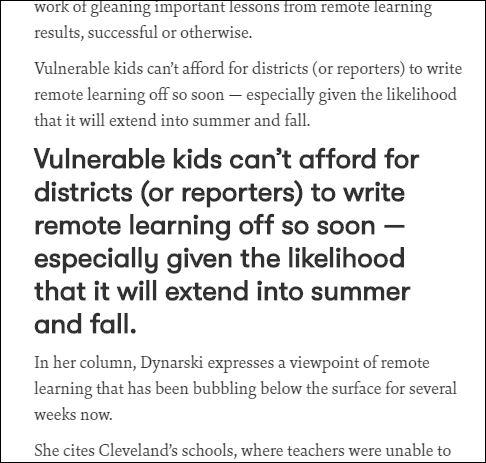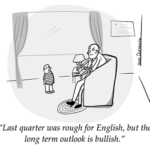A recent New York Times column about remote learning lets schools (and reporters) off the hook and undercuts the likelihood that subsequent efforts will be any more successful.
By Alexander Russo
On Thursday, University of Michigan professor Susan Dynarski penned a New York Times op-ed that had a lot of folks nodding their heads — including many reporters.
Headlined The School Year Really Ended in March, the piece is accompanied by an image of masked kids locked out of their brick-and-mortar school.
In it, Dynarski argues that for most kids, remote learning hasn’t worked and that we need to focus on a forward-thinking rescue operation.
“It’s time to admit that, for the vast majority of students, online learning and work sheets are no substitute for trained teachers in classrooms. For most children, the school year effectively ended in March.” – Dynarski
To be sure, there is an enormous amount of frustration with remote learning, and for good reason. Dynarski’s column captures that powerful zeitgeist.
And education reporters were among the quickest to praise Dynarski’s perspective:
“This is the ugly truth,” tweeted the NYT Sunday Magazine’s Pulitzer Prize-winning Nikole Hannah-Jones.
“Smartest thing I’ve read so far about remote learning,” tweeted the NYT’s metro education reporter, Eliza Shapiro.
However, the Dynarski column offers scant evidence for her blanket claim that remote learning isn’t working for most kids. And her proposal to focus our attention on future initiatives has at least two problems:
It fails to credit the schools, systems, and educators who may have — against enormous odds — managed to provide a robust remote learning program and stave off learning losses. And it exonerates districts that have failed to create even a minimally viable remote learning program.
It also gives journalists and others an out from the important work of gleaning important lessons from remote learning results, successful or otherwise.
Vulnerable kids can’t afford for districts (or reporters) to write remote learning off so soon — especially given the likelihood that it will extend into summer and fall.
Vulnerable kids can’t afford for districts (or reporters) to write remote learning off so soon — especially given the likelihood that it will extend into summer and fall.
In her column, Dynarski expresses a viewpoint of remote learning that has been bubbling below the surface for several weeks now.
She cites Cleveland’s schools, where teachers were unable to reach roughly 10 percent of students about their online lessons despite several followup efforts. There are many, many more examples.
Dynarski isn’t alone in suggesting that we write the whole thing off. A handful of districts have announced that they are going to end the year early, promising to provide summer opportunities and extended 2020-2021 offerings to make up for the loss.
But Dynarski doesn’t make much effort to back up her claim that the whole endeavor is a waste of time, and there are likely at least a handful of districts and charter networks that have had more success than others — even if we don’t know their names yet.
Dynarski doesn’t make much effort to back up her claim that the whole endeavor is a waste of time, and there are likely at least a handful of districts and charter networks that have had more success than others — even if we don’t know their names yet.
What we need now is more focus on the current remote learning efforts, not less. We need to mine this difficult experience for lessons, not write it off in favor of untested future plans.
Doing so will require asking some hard questions about how districts and educators have responded to the crisis, and what the results have been.
The obstacles and setbacks that they have experienced must be reported, addressed, and used to make sure that whatever programs come next do not repeat the same mistakes.
I’m grateful that current effort is still getting some of the attention it needs, including this recent New York Times piece contrasting private and public school offerings, penned by Dana Goldstein.
And at least some reporters have spoken out about the insufficiency of the remote learning that at least some children are being provided.
“There is no excuse why teachers cannot be offering some virtual instruction during the school day,” according to Hannah-Jones, whose daughter attends a Brooklyn school and who says she is “hearing from parents across the city and country who are getting no actual instruction for their kids.”
“There is no excuse why teachers cannot be offering some virtual instruction during the school day.” — New York Times reporter Nikole Hannah-Jones.
The educational future Dynarski fears — one in which a privileged minority of children are well educated, using private resources like tutors, private schools and home schooling — was with us already before COVID came along.
And it obviously has persisted during the last few weeks.
However, the best response to this lamentable situation isn’t to begin focusing on the future, as uplifting as that may feel.
If the remote learning effort is failing, journalists and researchers should be documenting what’s happening and pressing for improvements, both immediate and further off.
I’m not ready to stop paying close attention to what schools do with the month ahead. I’m not ready to write off about a third of the school year. And I’m definitely not ready to join everyone else who seems want to give schools a mulligan that vulnerable kids can least afford.
ABOUT THE AUTHOR

Alexander Russo
Alexander Russo is founder and editor of The Grade, an award-winning effort to help improve media coverage of education issues. He’s also a Spencer Education Journalism Fellowship winner and a book author. You can reach him at @alexanderrusso.
Visit their website at: https://the-grade.org/











